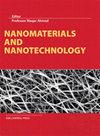桑汁碳量子点作为Cu2+离子传感器:果实成熟度对光学性质的影响
IF 3.3
3区 材料科学
Q2 MATERIALS SCIENCE, MULTIDISCIPLINARY
引用次数: 0
摘要
本研究以桑椹汁为碳源,采用水热法制备了具有绿色光致发光的碳量子点。以荧光光谱为重点,探讨了果实成熟度对其理化性质的影响。傅里叶变换红外光谱(FT-IR)和能量色散x射线分析(EDX)表明碳量子点(CQDs)为石墨状。结果表明,未成熟桑椹汁和成熟桑椹汁的CQDs的平均尺寸分别为7.4 nm和9.7 nm。当波长为400 nm时,这些CQDs分别在未成熟和成熟的桑椹汁中发出500 nm和510 nm的绿光。制备的CQDs具有激发依赖性的光致发光(PL)发射行为,表明其对激发光的依赖性。通过检测不同水果(包括番茄和黑莓)的荧光光谱,探讨了果实成熟度对光学特性的影响,并在桑葚果实中观察到类似的行为。此外,所制备的CQDs可作为高特异性Cu2+离子检测的荧光传感器。该传感器的检出限(DL)为0.2687µM,限定限(LOQ)为0.814µM。检测的线性范围为0.1 ~ 1µM。CQDs对Cu2+离子的选择性通过记录Cu2+离子的PL响应而不是其他金属离子的弱响应来证实。根据这些结果,CQDs可以应用于各种细胞成像和生物学应用,生物传感,光电子学和传感器。本文章由计算机程序翻译,如有差异,请以英文原文为准。
Mulberry Juice-Derived Carbon Quantum Dots as a Cu2+ Ion Sensor: Investigating the Influence of Fruit Ripeness on the Optical Properties
This study synthesized carbon quantum dots (CQDs) with green photoluminescence through a hydrothermal method that utilized mulberry juice as the carbon source. The influence of fruit ripeness on the physical and chemical properties, focusing on the fluorescence spectra, has been explored. Fourier-transform infrared spectroscopy (FT-IR) and energy dispersive X-ray analysis (EDX) showed that there were oxygen-containing groups, and X-ray diffraction (XRD) showed that the carbon quantum dots (CQDs) were graphitic. The results revealed that the CQDs had an average size of around 7.4 nm and 9.7 nm for unripe and ripe mulberry juice, respectively. These CQDs emitted green light at 500 nm and 510 nm in unripe and ripe mulberry juice, respectively, when excited at a wavelength of 400 nm. The prepared CQDs exhibited excitation-dependent photoluminescence (PL) emission behavior, demonstrating their dependence on the excitation light. The impact of fruit ripeness on optical properties was explored by examining fluorescent spectra from different fruits (including tomato and blackberry), demonstrating comparable behaviors observed in mulberry fruit. In addition, the prepared CQDs were utilized as a fluorescent sensor with high specificity to detect Cu2+ ions. The detection limit (DL) for this sensor was determined to be 0.2687 µM, and the limit of qualification (LOQ) is 0.814 µM. The linear range for detection lies between 0.1 and 1 µM. The selectivity of the CQDs towards Cu2+ ions was confirmed by recording the PL response for Cu2+ ions compared to the weak response of other metal ions. According to these results, the CQDs can be applied in various cellular imaging and biology applications, bio-sensing, optoelectronics, and sensors.
求助全文
通过发布文献求助,成功后即可免费获取论文全文。
去求助
来源期刊

Nanomaterials and Nanotechnology
NANOSCIENCE & NANOTECHNOLOGY-MATERIALS SCIENCE, MULTIDISCIPLINARY
CiteScore
7.20
自引率
21.60%
发文量
13
审稿时长
15 weeks
期刊介绍:
Nanomaterials and Nanotechnology is a JCR ranked, peer-reviewed open access journal addressed to a cross-disciplinary readership including scientists, researchers and professionals in both academia and industry with an interest in nanoscience and nanotechnology. The scope comprises (but is not limited to) the fundamental aspects and applications of nanoscience and nanotechnology
 求助内容:
求助内容: 应助结果提醒方式:
应助结果提醒方式:


